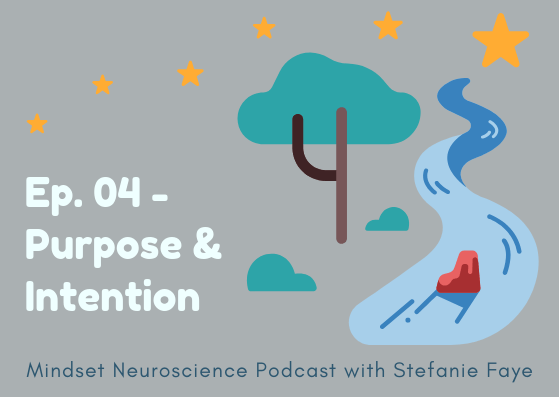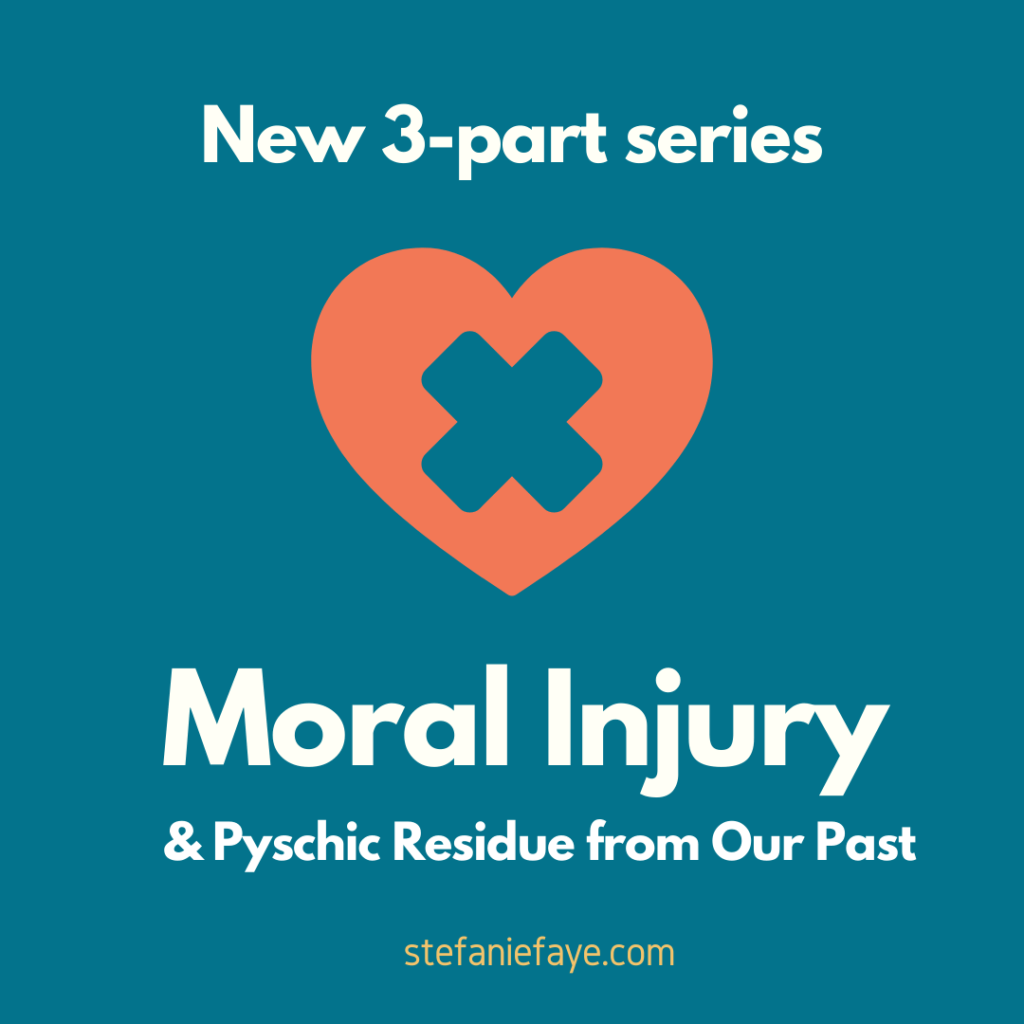
“The residues of the past and the content of the future tend to be formulated, constructed, and reconstructed in terms of that [traumatic] experience” (Dowling, 1986)
Read Moral Injury Part 2: Psychic trauma and annihilation anxieties
Read and listen to Part 3: Moral Injury, Forgiveness and Cognitive Flexibility
Every aspect of our cellular design is to solve a problem.
And that problem - from a cellular-machinery level - is homeostasis, which includes maintaining our systems as fully functioning to keep us alive, and projecting us into the future.
Much of this system maintenance and future projection is tied to the efficient use of energy: we need to preserve the ‘flesh barrier’ so that our system does not need to continuously use energy for repair of organs or fighting off of foreign invaders. Damage to the molecular structure of our physical vehicle means that energy is not purely focused on regular maintenance and future projection.
Because of this, threats to the physical integrity of our system are one of the highest priorities for us to protect ourselves from.
The brain-body system devotes many of its resources and algorithms to ensuring this physical integrity. Damage to physical integrity can come in obvious forms, such as a solid object actually piercing through the tight clustering of molecules that represent our physical body, as well as lack of energy units entering the body (in the form of liquids, solids and gases that hold molecular structures needed for body-maintenance, ie., water, nutrients, oxygen, etc.)
Because energy-efficiency is so critical, the brain-body system also devotes much of its resources to protecting us against anything that could indirectly lead to a physical disintegration of the physical body. These dangers are not necessarily physical. They are related to the fact that our homeostasis and future projection are intimately tied to social mechanisms.
Our first experiences as infants require us to be dependent on an attachment figure in order to survive. So those experiences lay a foundation for predictive algorithms of what other humans can offer us as we enter into future relationships.
Beyond infancy, we continue to depend on certain social patterns for our system maintenance and future projection.
To be able to adapt to changing circumstances and environmental factors, we need some type of community, however small, to help offset the energy usage needed to survive and project into the future. In some eras and communities, this might look like having some members stand guard while others sleep or eat (and are vulnerable to predators), to something more advanced like outsourcing the building of roads and food sources to some members, while other members use time to innovate more efficient ways of using energy for survival.
Because social mechanisms are also related to energy-efficiency, the threat of losing social connections is a top priority for our system to protect us against.
This means that an interaction or event that relates to a social loss may take on a sense of danger that deeply impacts our brain-body functioning, mental health and behaviors.
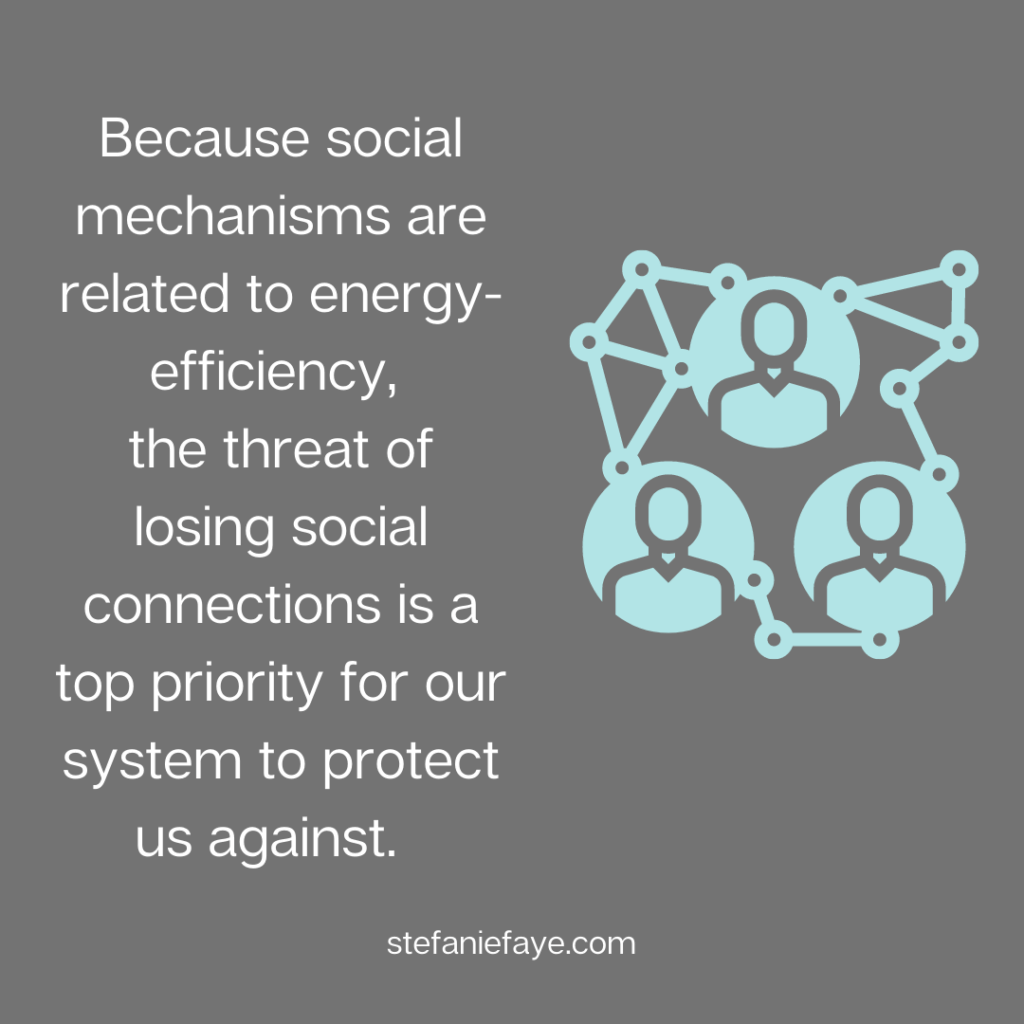
So when we talk about harm, threat and danger, we must also include - in addition to physical harm - the concept of loss and injuries related to our social functions and needs.
Our sense of wellbeing increases when we feel safe.
Feeling safe allows for our brain-body resources to not be focused on vigilance and defensive mechanisms. This frees up energy units to be used for restoration and maintenance of organs, and the more energy-expensive tasks of problem solving, planning for the future and long-term decision-making.
A powerful component of feeling safe is our role within a social system.
If we feel valuable and needed by others in the group, this decreases the chances of us being replaced or discarded, thus increasing our sense of safety. If we are able to connect and engage with others in ways that increase certain hormones like oxytocin, we feel a sense of bonding and attachment that helps regulate our cortisol levels and nervous systems. Bonding with someone also decreases the chance that we'll be discarded or replaced within a social group or dyad.
When we get exposed to situations where we either directly experience or witness any of these flesh-danger or social-danger mechanisms, this alerts our system to something that it is designed to protect us from.
If we can’t protect ourselves or others, it forces us to recognize a limitation or failure of the system we are a part of
If we are unable to do anything about these dangers - or if we contribute to one of these dangers (often not in a directly intentional way, but through being influenced by authorities or group think), it means that the system that is meant to minimize or avoid these physical or social dangers has failed.
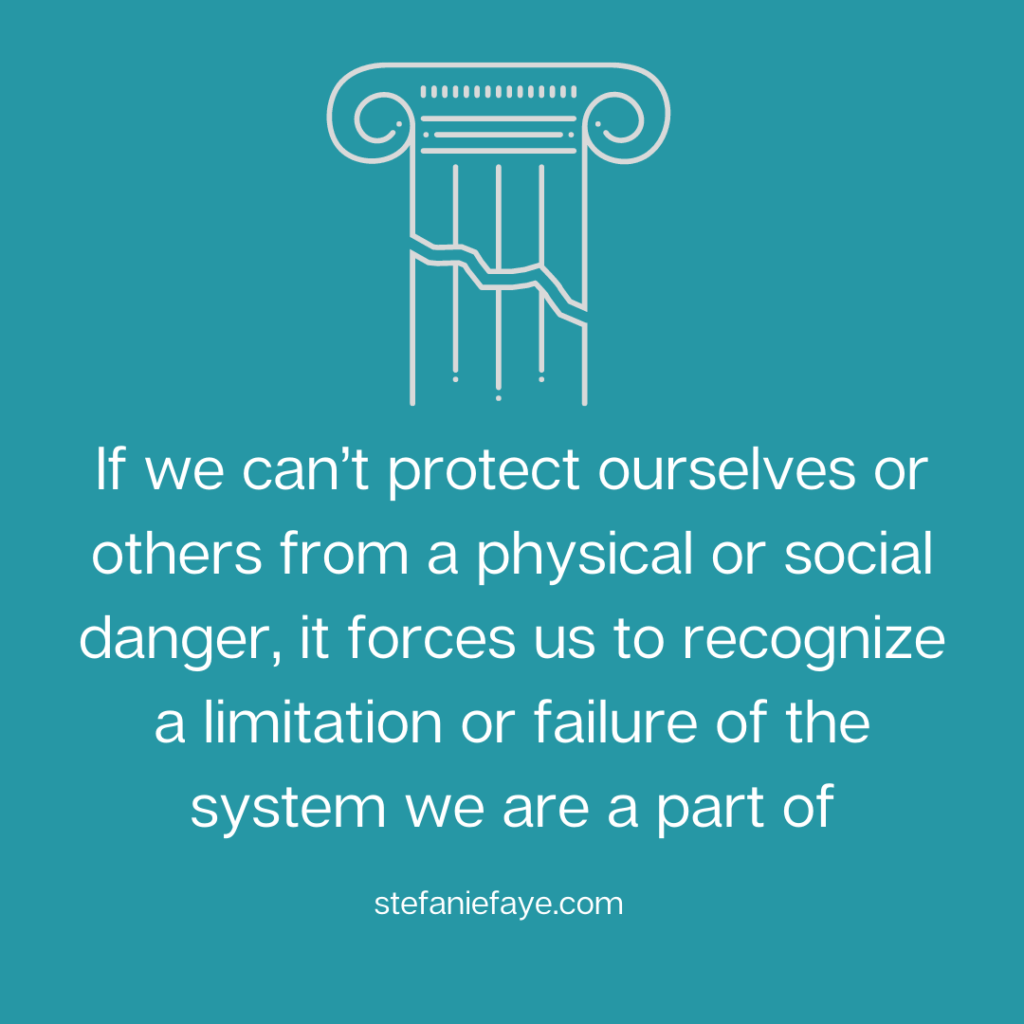
If for example, as a child, we witnessed behavior between two or more people - whether adults or children that entered the realm of physical or social danger, we may not have had the resources or skills to do something about it. Throughout our lives, we may contribute to or witness events or interactions that physically harm, threaten to physically harm, or socially endanger others (through mechanisms such as rejection, humiliation, shaming). All of these events alert our system not only to the fact that these dangers are or could affect someone else, but that they also could happen to us.
Being exposed to these physical and social threats on a regular basis keeps our nervous system engaged in a level of vigilance and protection.
What do you get when you expose hyper-connected, constantly communicating organisms to constant reminders of physical and social threat?
You get one exhausted and defensive species.
That is not an efficient use of energy in terms of maintenance of our internal systems and organs and complex brain processes such as problem-solving and long-term planning. In our hyper-connected world, we’ve amplified this exposure to physical and social danger to an extraordinary degree. A degree that is likely accelerating at a pace that our nervous systems can’t keep up with without some type of change in behavior and awareness.
Witnessing physical and social dangers without an ability to directly minimize these events are tied to a sense of loss of power and agency.
Loss of power and agency can lead to deeply haunting and consuming feelings of shame, guilt, self-condemnation, regret, rage, withdrawal and anguish. Numbing ourselves from those feelings may manifest as addictions, distractions, busy-ness and zoning out.
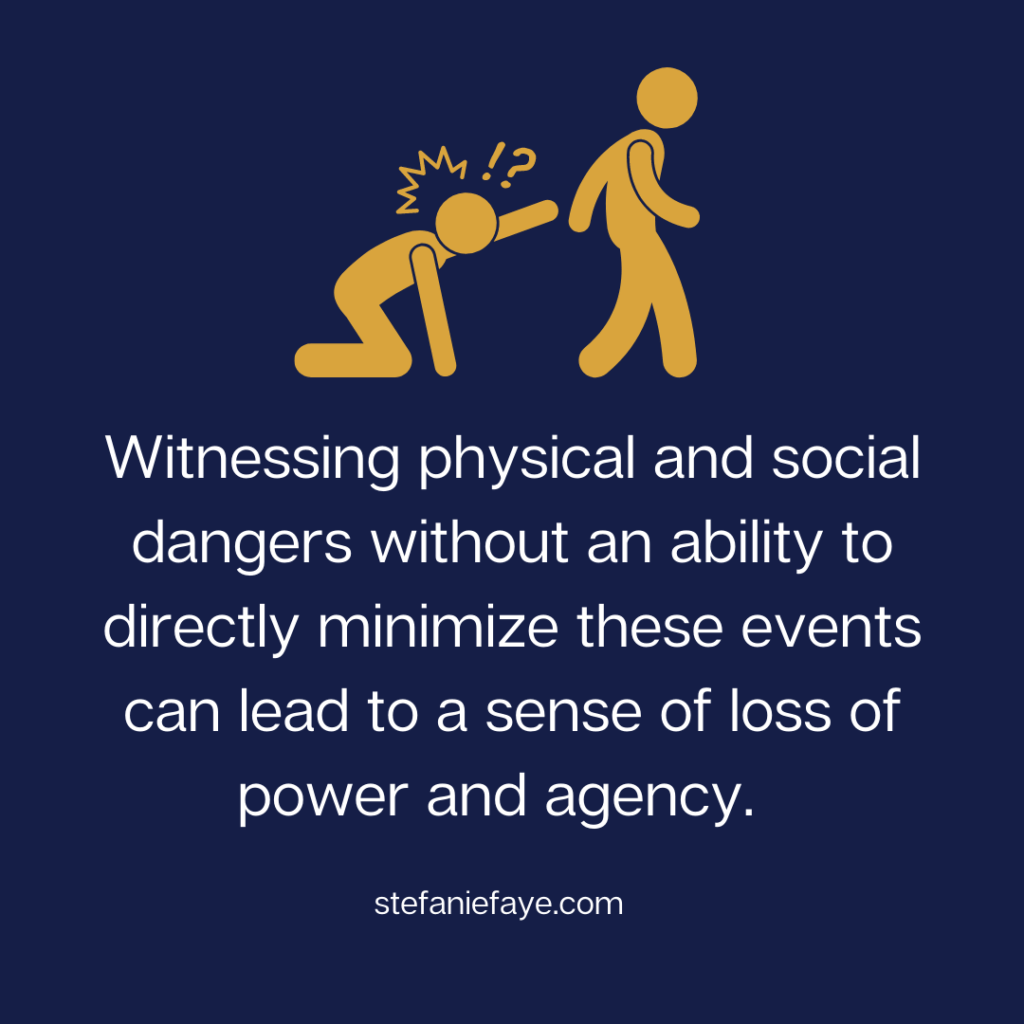
What are we to do?
First, having some type of awareness and framework for our experience can help us name what we are going through. As more of us are able to do this, we help each other recognize patterns, which can then help us come up with strategies.
Having no framework or words to resonate with what we are experiencing is disorienting and can be called ‘undifferentiated arousal’. It’s this lurking feeling of ‘something’s not right’. But ‘something isn’t right’ doesn’t help us come with ideas of what to do. As a pattern-recognizing, problem-solving super-organism, humans need to know how to focus their efforts. There needs to be some end-game or common point to which we are all referring. This unified intent is actually tied to brainwave coherence* which can help us achieve goals more efficiently (check out research by Caroline Szymanski and Suzanne Dikkers).
To help us get on to the same page, I’d like to bring up two important concepts that is related to these physical and social dangers: Moral Injury and Annihilation Anxieties.
Because of the importance of these topics, I’ll be devoting the next two articles to them.
In next week’s post, I’ll introduce you to some of the themes and examples of moral injury and annihilation anxieties.
In the following post, we’ll look at various strategies being explored to help people manage the deleterious effects of these experiences.
Know that when you are interacting with another human, there is a very very strong possibility that they have residue from their past.
That residue may linger within their nervous system and manifest as defensiveness, withdrawal, rage, guilt and shame. There is a good chance that annihilation anxieties are something they deal with -whether consciously or unconsciously.
The other commonality: every single being on the planet needs safety on a regular basis - from both physical and social dangers such as attack, shaming, humiliation, rejection and punishment.
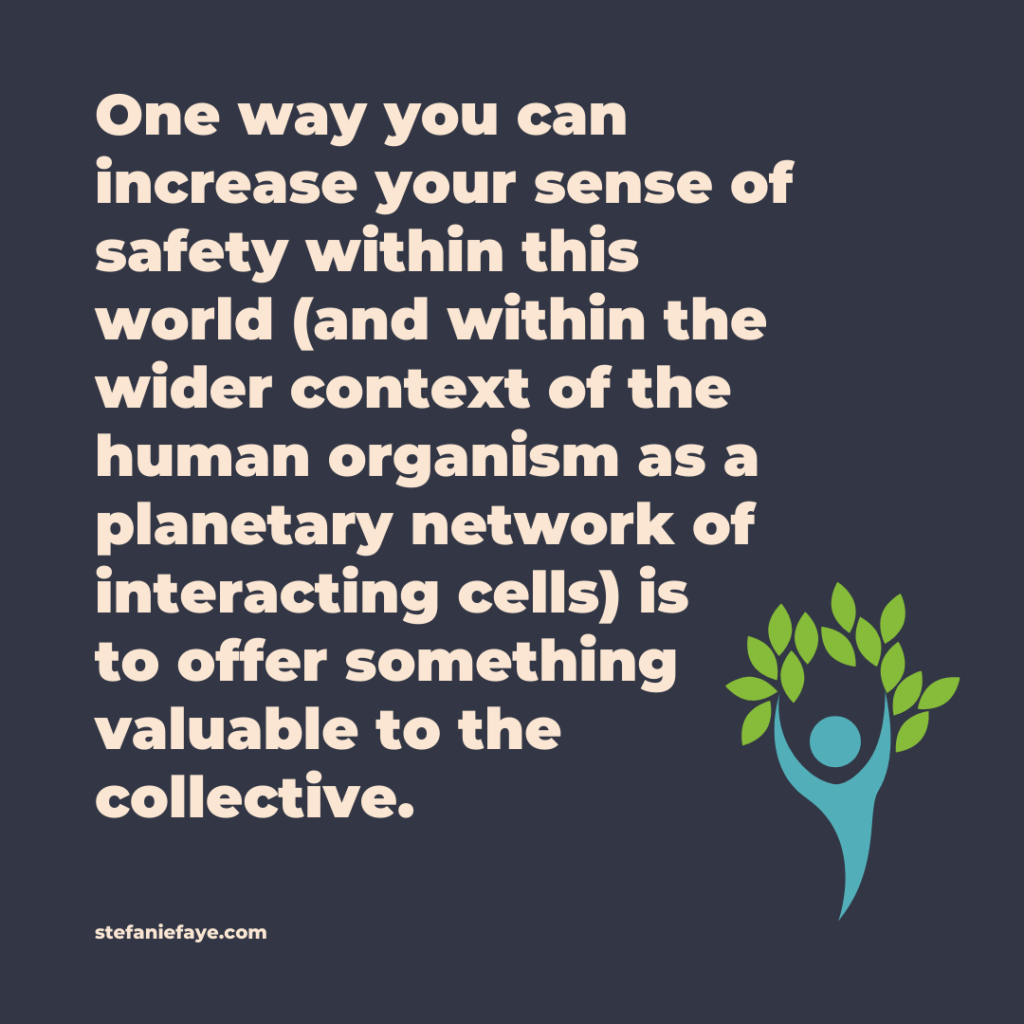
One way you can increase your sense of safety within this world (and within the wider context of the human organism as a planetary network of interacting cells) is to offer something valuable to the collective.
Something of extraordinary value is the offering of safety to another, so that the energy being diverted to their defense systems can finally return to their internal restoration, healing and long-term type of thinking. When you offer this to another, you have given the Human Tribe a moment of rest from the energy drain of attack, defense and retaliation.
Offering safety to another can take the form of
- signal flow: listening without interrupting, judging or shaming;
- recognition of their value: gratitude and noticing of something beautiful, vulnerable or valuable about them;
- compassion for any pain they have experienced
By extending this to another, you also increase your own sense of agency and power because it allows you to recognize that you can be a source or beacon of safety. A calm and powerful presence in the midst of a frenzied and fear-based storm of social frequencies. This reminds you of your value and power within the collective.
My top choices for training to be a beacon of safety for others (as a way to heal yourself as well):
- meditate every day for 15-20 minutes (there are plenty of resources on this, so use trial and error until you find something that resonates with you. My favorite teachers include Thich Nhat Hanh, Michael Singer, Jedda Mali, Eckhart Tolle and Sharon Salzburg)
- read books or attend online courses by teachers who promote internal sense of safety, meaning, purpose, etc. Sounds True is a great resource for these
- use every interaction throughout the day as an opportunity to tune in to your heart and breath, and then speak or react to what is going... slow down everything: your breathing, your movements, how you speak... all of this conveys an internal state and intention of psychological safety. You can still get your point across to someone without triggering them into sympathetic nervous system fight-flight mode (so feeling safe inside and conveying these signals does not make you a doormat. It actually conveys your strength more than defense/attack/flee mechanisms that we often transmit without realizing it)
When you give what you are seeking, you amplify it within your own awareness.
Read Moral Injury Part 2: Psychic trauma and annihilation anxieties
Read and listen to Part 3: Moral Injury, Forgiveness and Cognitive Flexibility
References:
Dowling, S. (1986). Discussion of the various contributions. In Rothstein, 1986, op cit., pp. 205-
217. Rothstein, ed. The Reconstruction of Trauma. Madison, CT: International Universities
Press..
TVO interview with Ruth Lanius: https://www.tvo.org/article/what-is-a-moral-injury-and-how-can-it-be-treated
Adaptive Disclosure: A New Treatment for Military Trauma, Loss, and Moral Injury by Brett T. Litz, Leslie Lebowitz, Matt J. Gray, William P. Nash
Jameton A. Nursing practice: the ethical issues. Englewood Cliffs, NJ: Prentice Hall, 1984
Litz, Brett T.; Stein, Nathan; Delaney, Eileen; Lebowitz, Leslie; Nash, William P.; Silva, Caroline; Maguen, Shira (December 2009). "Moral injury and moral repair in war veterans: A preliminary model and intervention strategy". Clinical Psychology Review. 29 (8): 695–706.
Shay, J. (2010). Achilles in Vietnam: Combat Trauma and the Undoing of Character. Simon & Schuster

